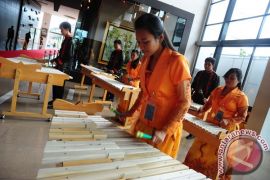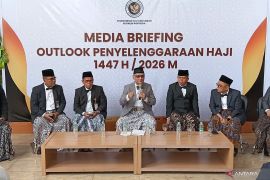"Competition is spoiling Jambi temple`s chance of getting recognition from the UNESCO as a world cultural heritage. There are other sites from other countries which also have the potential to be registered as world heritage," Sulkifli noted.Jakarta (ANTARA News) - The seventh-century Muarojambi Temple site, Indonesias largest Buddhist shrine complex of the ancient Malay Kingdom (7th-14th century AD), is now fighting to get recognition from UNESCO, as one of the worlds cultural heritages.
Located some 40 kilometers (km) from Jambi City in Sumatra, the 2,612-hectare (ha) Muarojambi Temple complex in Muarojambi District was registered for recognition on the tentative list of UNESCO in 2009. However, the world body has yet to grant it recognition.
According to Zumi Zola Sulkifli, Jambi Governor, stiff competition is keeping the UNESCO from declaring the Muarojambi Temple complex as a world cultural heritage.
"Competition is spoiling Jambi temples chance of getting recognition from the UNESCO as a world cultural heritage. There are other sites from other countries which also have the potential to be registered as world heritage," Sulkifli noted, after opening the Muarojambi Temple Festival on Thursday (May 11).
The regional government set up a team in 2016 to study and push for the recognition of the temple site as a world cultural heritage. "Along with the team, we will collect all that is needed, and this will take time, as well as sustained efforts," the governor said.
The local government pointed out that the Muarojambi Temple had the qualifications to be granted with the heritage status from the UNESCO. One of the qualification is that the temple complex should have historical significance. It is the largest in Indonesia, even in Southeast Asia.
Based on archaeological records, the Muarojambi Temple was built between the sixth and seventh centuries, and it served as a campus or education center for Buddhists to study Buddhism during the 11th century. It is a remnant of the Sriwijaya Kingdom.
Hence, the Muarojambi Temple still serves as a center of religious rituals for Buddhists, including during the Buddhist Waisak Day. Thousands of Buddhists and hundreds of monks took part in the procession for the commemoration of Waisak Day at the temple site, Thursday last week.
"More than 100 monks came to the Muarojambi shrine site to observe the Waisak Day," Governor Sulkifli revealed, Thursday. He said the monks had come not only from Jambi and other regions in the country, but also from Thailand and other countries.
After holding a procession, the monks also attended the Muarojambi Temple festival, which was organized to coincide with the observance of the Waisak Day. The event was themed on "Togetherness based on love, the diversity guardian."
"This morning, the complex was packed. Some six thousand Buddhists had come here," the governor revealed.
The Muarojambi Festival was held after the Buddhists performed the Waisak ritual. The event attracted many visitors to Indonesias largest temple complex.
"They came from other regions such as Jakarta. They had also come from Malaysia," the governor observed.
Noted monk Jangchup Choeden, who led a delegation of seven monks from India, Nepal and Bhutan on a religious tour of the Muarojambi Temple last September, mentioned that the Buddhist teaching of morality in Tibet had been adopted from the teaching of Guru Atisha of Muarojambi, Jambi province.
Now, the temple compound covers 2,612ha, with at least 82 ancient buildings made of bricks and located in the Muarojambi District. The site can be reached by land or river in an hour.
Guru Choeden explained that during the Muarojambi era in the 11th century, the Great Guru Atisha of Tibet lived and studied morality in the Muarojambi Temple complex for 11 years, from about 1011-1023 AD.
"Therefore, the teaching of Guru Atisha in Tibet is closely related with Buddhist teachings in Muarojambi. This has been proved by archaeological findings and in history," he highlighted.
During his tour of the largest Southeast Asian temple complex, Choeden admitted his delegation and he were impressed with the temples buildings.
Esthy Reko Astuty, Deputy for Tourism Development and Marketing of the Ministry of Tourism, observed that the Muarojambi Temple site was a potential religious and historical tourism site, which should be developed to attract visitors.
"This temple site is a potential religious and spiritual tourism destination for the Buddhist community," Astuti said, while attending the Muarojambi Temple Festival on Thursday (May 11).
Hence, the regional government is giving attention to its development.
The development of the Muarojambi Temple complex is in line with the development program of President Joko Widodo. For the Muarojambi Temple site is rich in historical values and can become one of the countrys magnets in increasing regional economic activities in the tourism sector.(*)
Reporter: Andi Abdussalam
Editor: Heru Purwanto
Copyright © ANTARA 2017











